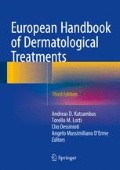Abstract
Leishmaniasis is a protozoan disease transmitted through the bite of a sandfly infected with leishmania parasites. Visceral leishmaniasis, also known as kala-azar, is a systemic disease, and it is usually diagnosed by the presence the organisms in the spleen, lymph gland, or bone marrow aspirates. Cutaneous leishmaniasis usually occurs in the form of an ulcerated nodule on the skin Patients with lesions on the face or another cosmetically important area should be treated to reduce the size of the resultant scar. The most successful therapy is intralesional therapy. Systemic chemotherapy is recommended for very extensive lesions. Uncomplicated lesions do not need to be treated aggressively. Simple excision, cryosurgery, and topical therapy are usually sufficient.
Access this chapter
Tax calculation will be finalised at checkout
Purchases are for personal use only
References
Loiseau PM, Cojean S, Schrével J. Sitamaquine as a putative antileishmanial drug candidate: from the mechanism of action to the risk of drug resistance. Parasite. 2011;18(2):115–9.
Sharquie VE, Najim RA, Farjou IB, Al Timimi DJ. Oral zinc sulphate in the treatment of acute cutaneous leishmaniasis. Clin Exp Dermatol. 2001;26:21–6.
Further Reading
Aronson NE, Wortmann GW, Byrne WR, Howard RS, et al. A randomized controlled trial of local heat therapy versus intravenous sodium stibogluconate for the treatment of cutaneous Leishmania major infection. PLoS Negl Trop Dis. 2010;9(3):e628. doi:10.1371/journal.pntd.0000628. Pubmed PMID.
Asilian A, Sadeghinia A, Faghihi G, Momeni A. Comparative study of the efficacy of combined cryotherapy and intralesional meglumine antimoniate (glucantime) vs cryotherapy and intralesional meglumine antimoniate (glucantime) alone for the treatment of cutaneous leishmaniasis. Int J Dermatol. 2004;43:281–3.
Boletis JN, Pefani SA, Stathakis C, et al. Visceral leishmaniasis in renal transplant recipients; successful treatment with liposomal amphotericin B(AmBisome). Clin Infect Dis. 1999;28:1308–9.
Davidson RN. AIDS and leishmaniasis. Genitourin Med. 1997;10:298–9.
El Darauti MA, al Rubaie SM. Cutaneous leishmaniasis. Treatment with combined cryotherapy and intralesional stibogluconate injection. Int J Dermatol. 1990;29:56–9.
El On J, Livshin R, Even PZ. Topical treatment of cutaneous leishmania. J Invest Dermatol. 1986;87:284–8.
Gardlo K, Hanneken S, Ruzicka T, Neumann NJ. Photodynamic therapy of cutaneous leishmaniasis. A promising new treatment. Hautarzt. 2004;55:381–3.
Grevelink SA, Lerner EA. Leishmaniasis. J Am Acad Dermatol. 1996;34:257–72.
Gürel MS, Tatlı M, Özbilge H, et al. Efficacy of cryotherapy and intralesional pentostam in treatment of cutaneous leishmaniasis. J Egypt Soc Parasitol. 2000;30:169–76.
Herwaldt BI. Leishmaniasis. Lancet. 1999;354:1191–9.
Herwaldt BI, Berman JD. Recommendations for treating leishmaniasis with sodium stibo-gluconate (Pentostam) and review of pertinent clinical studies. Am J Trop Med Hyg. 1992;46:296–306.
Higashi GI. Vaccines for parasitic diseases. Ann Rev Public Health. 1988;10:560–86.
Kim DH, Chung HJ, Bleys J, Ghohestani RF. Is paromomycin an effective and safe treatment against cutenous leishmaniasis? A meta analysis of 14 randomized controlled trials. Plos Negl Trop Dis. 2009;3:381e.
Kochar DK, Aseri S, Sharma BV, Bumb RA, et al. The role of rifampicin in the management of cutaneous leishmaniasis. OJM. 2000;93:733–7.
Kolde G, Luger T, Sorg C, et al. Successful treatment of cutaneous leishmaniasis using systemic interferon gamma. Dermatology. 1996;192:56–60.
Memisoglu HR, Kotogyan A, Acar MA, et al. Cryotherapy in cases with leishmaniasis cutis. J Eur Acad Dermatol Venereol. 1995;4:9–13.
Mohammadzadeh M, Behnaz F, Golshan Z. Efficacy of glucantime for treatment of cutaneous Leishmaniasis in central Iran. J Infect Public Health. 2013;6(2):120–4.
Moskowitz PF, Kurban KA. Treatment of cutaneous leishmaniasis; retrospectives and advances for the 21st century. Clin Dermatol. 1999;17:305–15.
Mujtaba G, Khalid M. Weekly vs fort nightly intralesional meglumine antimoniate in cutaneous leishmaniasis. Int J Dermatol. 1999;38:607–9.
Oliveria M, Armondo A, Mathots M, et al. Intralesional therapy of American cutaneous leishmaniasis with pentavalent antimony in Rio de Janeiro, Brazil an area of leishmania transmission. Int J Dermatol. 1997;36:463–8.
Samady JA, Schwartz RA. Old world cutaneous leishmaniasis. Int J Dermatol. 1997;36:161–6.
Sundar S, Chakravarty J. Leishmaniasis: an update of current pharmacotherapy. Expert Opin Pharmacother. 2013;14:53–63.
Sundar S, Singh A, Rai M, et al. Efficacy of miltefosine in the treatment of visceral leishmaniasis in India after a decade of use. Clin Infect Dis. 2012;55:543–50.
Uzun S, Durdu M, Culha G, Allahverdiyev AM, Memisoglu HR. Clinical features, epidemiology, and efficacy and safety of intralesional antimony treatment of cutaneous leishmaniasis: recent experience in Turkey. J Parasitol. 2004;90:853–9.
Vardy D, Barenholes Y, Cohen R, et al. Topical amphotericin B for cutaneous leishmaniasis. Arch Dermatol. 1999;135:856–7.
Zakai HA, Zimmo SK. Effects of itraconazole and terbinafine on leishmania major lesions ın BALB/C mice. Ann Trop Med Parasitol. 2000;94:787–91.
Author information
Authors and Affiliations
Corresponding author
Editor information
Editors and Affiliations
Rights and permissions
Copyright information
© 2015 Springer-Verlag Berlin Heidelberg
About this chapter
Cite this chapter
Onder, M., Gürer, M.A. (2015). Leishmaniasis. In: Katsambas, A.D., Lotti, T.M., Dessinioti, C., D’Erme, A.M. (eds) European Handbook of Dermatological Treatments. Springer, Berlin, Heidelberg. https://doi.org/10.1007/978-3-662-45139-7_50
Download citation
DOI: https://doi.org/10.1007/978-3-662-45139-7_50
Publisher Name: Springer, Berlin, Heidelberg
Print ISBN: 978-3-662-45138-0
Online ISBN: 978-3-662-45139-7
eBook Packages: MedicineMedicine (R0)

